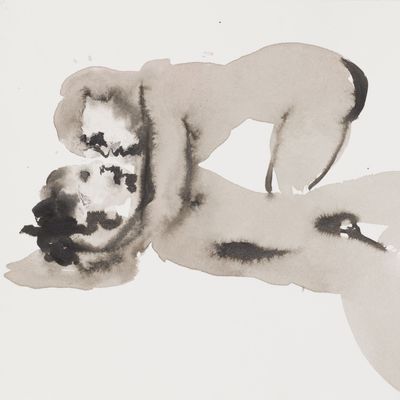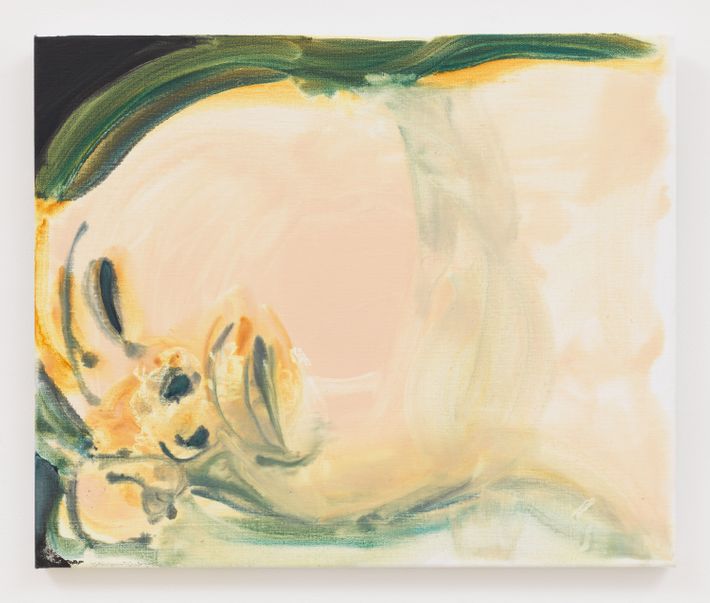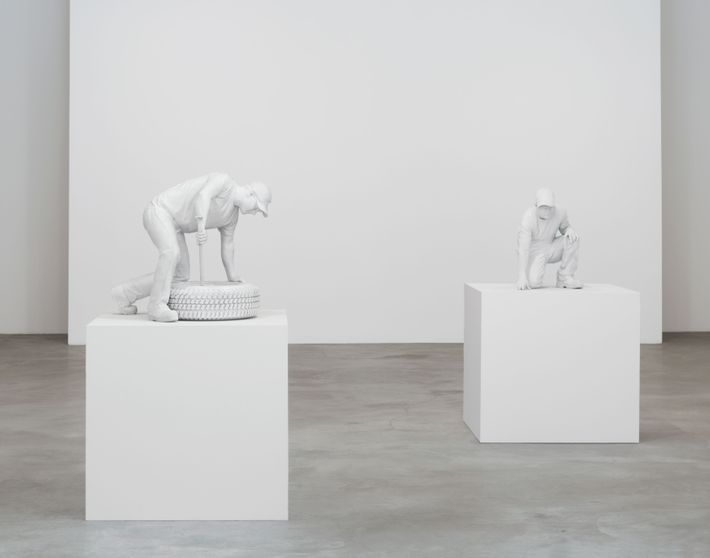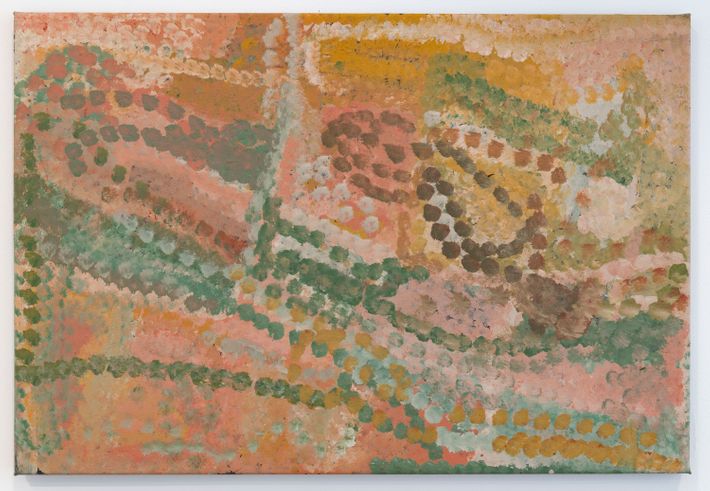
To coincide with several big art fairs and last week’s massive auctions, many larger galleries mounted shows of their bigger artists. So let’s read the tea leaves on the upper end of the food chain.
Huang Yong Ping
Bank of Sand, Sand of Bank
Gladstone Gallery
Critic Peter Schjeldahl coined the term “festivalism” in 1999 to describe the by-then already ubiquitous style of huge works produced by large teams of artist-assistants for big biennials and galleries, works that capture our attention for a frisky minute with their scale and ambition — and then almost instantly fade to blah. Huang Yong Ping’s huge, 20-ton sand-and-concrete re-creation of a neoclassical/colonialist Shanghai building fits the festivalist bill to a tee — and in fact was originally created almost 20 years ago for the 2000 Shanghai Biennale that marked the ascent of this now-well-known artist. Once upon a time, this piece was said to “interrogate” colonialism and appropriation, but whether or not its politics can still be gleaned at all, the thing is an impressive sight here in the middle of Chelsea — for about a minute.
Urs Fischer
Sotatsu
Gagosian
It’s never a pretty sight to see an artist who’s usually as electric, challenging, and sparking as Urs Fischer lay such a visually, physically, and conceptually inert egg. No amount of press-release explanation — about how these nine large, ultraslick oil-on-aluminum panels are about the artist stretching, dividing, fragmenting, opening, or closing space — and no shortage of forced highbrow evocation of 17th-century Japanese scrolls, landscapes, cranes, gardens, historical themes, and “new technologies” — offset the dead retinal and emotional effect that this painting produces. It is an inert nullity.
Dan Colen
Mailorder Mother Purgatory
Levy Gorvy
Dan Colen’s 12 huge new paintings — of things like J.Crew and Land’s End catalogue details (why?), tree trunks against a blue sky that the press release says is taken from a still from the movie Bambi, and some swirly red shapes said to derive from Walt Disney’s Fantasia — certify that this artist is flailing, making art that tries to comment on color-field, minimalist, and Abstract Expressionist painting, channeling bad-boy tropes of appropriation, and being so beholden to Jeff Koons and Richard Prince that it almost makes you wince with embarrassment. A number of years ago, Colen — who’s a very famous artist, has been on the cover of this magazine, has shown all over the world, and is represented by Gagosian — stopped me at a gallery and said, “Why are you so mean to me in your writing?” Startled, as I didn’t know him at the time — and still don’t — but I liked him immediately, I felt bad and said, “I’m not being mean, I’m just writing about my reactions to your work, none of which has dented or hurt your career at all.”
Al Freeman
More Comparisons
Bortolami
Last year when I posted one of Al Freeman’s so-called “Comparisons” — her simple two-part collages where she compares two found photos or images from books and the internet, say Diane Arbus’s famous portrait of a naked man with his genitals tucked between his legs and a well-known picture of Chris Christie in a baseball uniform sporting what can only be called a camel toe — hundreds of people took to Instagram branding her “anti trans.” In fact her imagination was not vile, depraved, and hating (as the internet claimed) but amazingly alive to the nuances of vision and visual coincidence — pictures that rhyme or that seem to bring out things in other pictures or that simply provide wonderful frissons of delight. For her untamed, flowing show “More Comparisons,” in this excellent Tribeca outpost, Freeman places images together like a de Kooning sculpture with Kermit the Frog, a kissing couple by Picasso with two drunks kissing with their faces smashed together Cubist-like, an image of multicolored wall-mounted silicon dildos and a squadron of Twombly’s flying phalli — all to show us that this artist will not sit down or shut up, social-media shaming notwithstanding.
Jenny Saville
Ancestors
Gagosian
Some 20 years ago, English collector and puppet master of all things British, the advertising mogul Charles Saatchi spotted the work of then-22-year-old Jenny Saville, bought all the work out of her senior show, gave her an 18-month contract, and almost overnight this seemingly conservative figure painter began showing just how radical conservative painting can be. However, other than the immense scale of her work, the fabulous large-size models she pictures, and her sometimes succulent slathering and scraped brushwork, her work has always been repetitive; as much as her paintings can “wow,” her effect is still based more on the impact of her strong feminist subject matter than on anything really that gripping or original about the way she painted. Saville seems to have realized this too; or maybe she just needed to change up her art so that here, with these paintings, which break into some new territory, she’s involved with a flatter, more imagistic and surreal fracturing of her models that recalls George Condo and Francis Bacon — but that still have a long way to go to be in the least bit gripping.
Wade Guyton
Patagonia
Petzel
Well this could be embarrassing: I’ve been a big fan of Wade Guyton’s digitally generated, collaged, Adobe Photoshopped, bitmapped files; UltraChrome, DuraBrite inkjet on linen; and Epson-printed paintings almost since he emerged in the early 2000s — all the way through him becoming a mega-artist selling works for millions and all the way past his impressive 2013 Whitney Museum retrospective. I’m not saying that Guyton is out of gas, but the 11 big paintings in his show are annoyingly self-referential — picturing things like his work drying on the floor, scraps of canvas, the remains of his assistants’ lunches. Combined with semi-abstract shapes that evoke minimalists and post-minimalists like Donald Judd, Keith Sonnier, and his teacher Robert Morris, these works show Guyton treading water (at best), not really pushing his process, scale, surfaces, or tools, and may be breathing his own fumes a bit too much — not a good place for an artist who depends on, as he once said, looking for “a space where objects could be speculative.”
Doug Aitken
New Era
303 Gallery
Since having his work on the cover of the 1997 Whitney Biennial catalogue and being about the best there was at conjuring the border-to-border, edge-to-edge seamless hum of modern life and commerce of late-20th-century existence, the California video artist Doug Aitken has excelled at multi-screened surround installations depicting whole cities from above, abandoned airfields in the desert, and parking lots lit by video — all summing up a world kindled night and day, powered by capitalism and flowing in what used to be called “the end of history.” It’s been extraordinary, then, to see Aitken adapt and be able to represent the complexly jagged contested space of the present, the jarring recognitions that come every minute, the political world never far away. Unlike German photographer Andreas Gursky, who has struggled mightily and unevenly with this post-9/11 space, sometimes unable to not return to a 2001 time, Aitken continues to successfully to master this relevantly, effectively, and mesmerizingly.

Marlene Dumas
Myths & Mortals
David Zwirner
They don’t get much bigger in the painting world than South African–born, Amsterdam-based Marlene Dumas, known for decades for her quasi-Expressionistic, washy Impressionistic, blurry photo-based paintings of troubled hot spots, naked babies, dead bodies, women mourning in cemeteries, armed soldiers, sex, terrorism — and who, in some way, created my social-media persona. One day in the early 2000s, bored with posting my status on Facebook as “Working” or “Getting ready to go on a trip,” and fresh from seeing a Dumas show, I wrote something to the effect that I found Dumas’s use of the photo, her painting style, and her opportunistic subject matter not to my liking — and said so (people went bonkers against me). Even though Dumas’s work still strikes me as repetitive, in this show she has upped the ante with what seem like more personal pictures of her daughter, pregnancy, women’s bodies, and something sexier than ever before — more honestly abject, closer to a human coil.
Jordan Wolfson
Riverboat song
David Zwirner
Jordon Wolfson’s videos (of extreme violence or a rabbi spouting sexual gibberish) and sculptures (an animatronic lap-dancing doll or a gigantic Pinocchio figure jerked around and smashed to the floor by an elaborate computer-controlled mechanical rigging) incubate such polyps of discomfort within me that, since he emerged around 2009, I’ve found myself skittish to say that I think he’s a maybe great artist. His latest video — comprised of 16 interconnected and ultracoordinated monitors, like one giant flat-screen TV in the middle of this huge carpeted gallery — isn’t as threatening or scary as previous works, and may not be up to snuff insofar as the ambiguity and open-endedness that he usually weaves perfectly — and here tilts a little more toward an inconclusive entertainment. Still, when his male figure suddenly grows breasts and a female rump, sheds them, and then starts running around with his penis out spraying urine all over the screen while Bob Dylan blasts from the superslick, jacked-up sound system, I imagine that any art lover worthy of the term will squirm — which is this artist’s sweet spot.

Charles Ray
three rooms and the repair annex
Matthew Marks Gallery
After being one of the premiere sculptors of the 1980s and 1990s, Los Angeles–based genius Charles Ray turned from strange visual effects and trippiness to far more laborious, time-consuming techniques, hard-to-work materials, and older forms, and starting in the early 2000s made some astounding works that seemed to say, “Since contemporary sculpture appears to be played out, let’s retrieve familiar forms and techniques to make something supposedly old, new again.” Like a naked boy holding a frog, or a pair of naked figures — one black, one white (said to represent Huckleberry Finn and the runaway slave Jim) — each of which was either removed (in the case of the frog-boy, in Venice) or not allowed to be installed at all (the latter work rejected by the Whitney Museum). At Matthew Marks, five works made variously of solid stainless steel, sterling silver, machined aluminum — especially the duo of a car mechanic — called to mind ancient sculptures like Dying Gaul and Boy Removing a Thorn From His Foot, works that depict semi-bent-over figures lost in their own worlds of contemplation, and made me think about the complex relationship we have with mechanics, these figures from an almost-gone world, the last ones who can take care of machines that we have made too complex for anyone but experts to repair.
Takashi Murakami
Heads Heads
Perrotin
Don’t let the scads of curious tourists peeping at these paintings, thinking that they’re seeing one of the living masters of pop contemporary art, Takashi Murakami, make you think that the three floors of new paintings and drawings by this world-famous artist are anything but ultraslick, super-high-priced empty visual fizz and froth. Nevertheless, collectors eat them up for their supposed connection to serious historical styles; in this case the work owes a special debt to Francis Bacon, that go-to default artist for painters like Murakami (and Saville, above) who are starting to run on empty. Here, the Japanese artist gives us a number of cute, cartoony recapitulations of the English existentialist master and so creates yet another building full of expensive doodad placeholders for rubes.
Damien Hirst
Color Space Paintings
Gagosian
What is it with super-famous male artists who emerged in the 1990s — like Murakami, Fischer, and Hirst — who can never take time off or say no to a show, or who, when they have shows, have to have them huge and packed to the rafters? I like Hirst’s dot paintings so much that I actually paid someone $155 to make me a perfect small copy of one of these happy, always cheery, pretty things; every day I look at mine, I feel chipper for whole seconds at a time, and am happy. I went to this show of new dot paintings, then, at least expecting to feel some of that, but of course, as with all these almost-over-the-hill art stars, Hirst has to fill three gigantic galleries with the things, and of course has to make them immense, palace-sized, and therefore pretty silly; it’s like he’s saying, “See, I’m on automatic pilot, buffered from reality, and being told that these are all good.”

Beyond the Veil
Curated by Adam Knight
Olsen Gruin
No doubt many of the bigwigs in town for all the art stars, megagalleries and super-auctions, missed maybe the best secret show in New York at the moment, this six-artist exhibition of Australian Aboriginal women painters curated by the president of the Aboriginal Art Association of Australia — a show that gives us a breathtaking small survey of what critic Robert Hughes (who in almost every case except this I disagreed with) called “the last great art movement of the twentieth century.” Start with the tremendous late Emily Kame Kngwarreye, who started painting in her 70s, but whose strangely structured, still amorphous compositions of smears, dots, daubs, and squiggles create rippling worlds, undergrowth, river scenes, and complex cosmic interior space; and contrast her Rothko-like ruminations to the more detailed, pictorial, and symbolic images created by Gabriella Possum Nungurrayi, and then to a mind-blowing group effort made by a collective of women that looks like a magic-carpet quilt for the spirit. It’s time for these artists and many others to be shown in and collected by museums, placed in context, installed for good in permanent collections along with other such “outsider” and “self-taught” artists, and to finally scrap our sick, desolated, apartheid-like systematic exclusion of any but “insider” artists.

